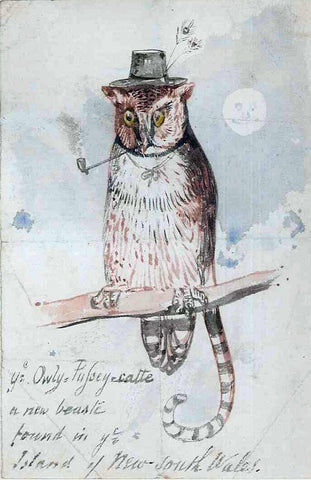
Edward Lear (British, 1812-1888), Ye Owly Pusseycatte, a new Beast found in ye Island of New South Wales
Edward Lear (British, 1812-1888)
Ye Owly Pusseycatte, a new Beast found in ye Island of New South Wales
Watercolor on laid paper
Inscribed with title lower left
Paper size: 5 ¼ x 3 ½ in
Provenance: George and Fanny Coombe (née Drewitt), Peppering House, Sussex
This is likely to be the earliest drawing in which Lear combines the Owl and the Pussycat, assuming it also dates to the mid 1840s. He is perched on a branch smoking a churchwarden pipe and wearing a settler’s wide-awake hat with two peacock feathers attached and a smiling moon beyond. The mention of New South Wales suggests this drawing dates to a similar period as an undated pen and ink drawing in the Pierpont Morgan Library, New York entitled `Portraites of the inditchenous beestes of New Olland’ which Vivien Noakes suggests was inspired by John Gould’s visit to Australia in 1838 to work on Birds of Australia (see Vivien Noakes, Edward Lear 1812-1888, exhibition catalogue, 1986, p.180, no.90). New Holland was the historical name for Australia.
The Drewitt family were childhood friends of Lear living at Peppering House near Arundel, Sussex. Lear’s sister Sarah married Charles Street in 1822 and moved to near Arundel so Lear was a frequent visitor to the area. Fanny Drewitt married George Coombe probably in 1831 and they lived at Peppering House. A group of letters from Lear to the Coombes were rediscovered in the 1990s and were at Christie’s on June 29, 1995. They are now in the Frederick Warne Archive. They provide a useful early record of Lear’s life and movements.
.
Lear was already drawing “for bread and cheese” by the time he was aged sixteen and soon developed into a serious “ornithological draughtsman” employed by the Zoological Society and then from 1832 to 1836 by the Earl of Derby, who kept a private menagerie at his estate, Knowsley Hall. He was the first major bird artist to draw birds from real live birds, instead of skins. Lear’s first publication, published when he was nineteen years old, was Illustrations of the Family of Psittacidae, or Parrots in 1830. One of the greatest ornithological artists of his era, he taught Elizabeth Gould while also contributing to John Gould’s works and was compared favorably with John James Audubon. Unfortunately his eyesight deteriorated too much to work with such precision on fine drawings and lithographic stones, thus he turned to landscape painting and travel.
In 1842, Lear began a journey into the Italian peninsula, traveling through the Lazio, Rome, Abruzzo, Molise, Apulia, Calabria, and Sicily. In personal notes, together with drawings, Lear gathered his impressions on the Italian way of life, folk traditions, and the beauty of the ancient monuments. He eventually settled in San Remo, on his beloved Mediterranean coast, in the 1870s, at a villa he named “Villa Tennyson.”
In 1846, Lear published A Book of Nonsense, a volume of limericks that went through three editions and helped popularize the form and the genre of literary nonsense. In 1871, he published Nonsense Songs, Stories, Botany and Alphabets, which included his most famous nonsense song, The Owl and the Pussycat, which he wrote for the children of his patron Edward Stanley, 13th Earl of Derby. Many other works followed.
Lear’s nonsense books were highly popular during his lifetime, but a rumor developed that “Edward Lear” was merely a pseudonym, and the books’ true author was the man to whom Lear had dedicated the works, his patron the Earl of Derby. Promoters of this rumor offered as evidence the facts that both men were named Edward, and that “Lear” is an anagram of “Earl.”
Lear’s nonsense works are distinguished by a facility of verbal invention and a poet’s delight in the sounds of words, both real and imaginary. A stuffed rhinoceros becomes a “diaphanous doorscraper.” A “blue Boss-Woss” plunges into “a perpendicular, spicular, orbicular, quadrangular, circular depth of soft mud.” His heroes are Quangle-Wangles, Pobbles, and Jumblies. One of his most famous verbal inventions, the phrase “runcible spoon,” occurs in the closing lines of The Owl and the Pussycat, and is now found in many English dictionaries.
Among other travels, he visited Greece and Egypt during 1848–49, and toured India during 1873–75, including a brief detour to Ceylon. While traveling he produced large quantities of colored wash drawings in a distinctive style, which he converted later in his studio into oil and watercolor paintings, as well as prints for his books. His landscape style often shows views with strong sunlight, with intense contrasts of color.
Throughout his life he continued to paint seriously. He had a lifelong ambition to illustrate Tennyson’s poems; near the end of his life a volume with a small number of illustrations was published.
After a long decline in his health, Lear died at his villa in 1888 of heart disease, from which he had suffered since at least 1870.
or by email at loricohen@aradergalleries.
We Also Recommend





